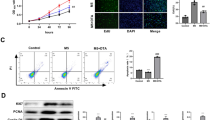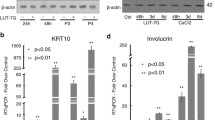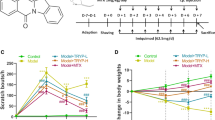Abstract
Psoriasis is a one of the most common chronic skin diseases, which affects 0.6–4.8 % of the general population. Amentoflavone (AMF) belongs to the biflavonoid class of flavonoids, possessing various biological effects, such as anti-inflammatory, antioxidant, and anti-apoptotic effects. In the present study, we aimed to investigate the effect of AMF on psoriasis in imiquimod (IMQ) psoriasis-like lesions in mice and keratinocyte proliferation in HaCaT cells. We showed that AMF reduced skinfold thickening, and improved erythema and scaling scores and histological lesions in IMQ-treated mice. AMF exerted potent anti-inflammatory effect via influencing a variety of proinflammatory cytokines, including tumor necrosis factor α, interleukin (IL)-17A, IL-22, and IL-23 in local skin lesions and the whole body. In M5 (a cocktail of cytokines)-treated HaCaT cells, AMF significantly inhibited cell proliferation, promoted apoptosis, and inhibited the increase of expression of cyclin D1, cyclin E, IL-17A, and IL-22. In addition, AMF inhibited the upregulation of p65 NF-κB under psoriatic condition. Moreover, overexpression of p65 NF-κB significantly suppressed the effect of AMF on keratinocyte proliferation, apoptosis, and expression of cyclin D1, cyclin E, IL-17A, and IL-22. These results demonstrated that suppression of NF-κB was involved in AMF-resulted anti-proliferative, apoptosis-promoting, anti-inflammatory effects in keratinocytes. The data demonstrate that AMF may serve as potential therapeutic option for patients with psoriasis.




Similar content being viewed by others
References
Naldi L (2004) Epidemiology of psoriasis. Curr Drug Targets Inflamm Allergy 3:121–128
Nestle FO, Kaplan DH, Barker J (2009) Psoriasis. N Engl J Med 361:496–509
Raychaudhuri SP, Farber EM (2001) The prevalence of psoriasis in the world. J Eur Acad Dermatol Venereol 15:16–17
Harden JL, Krueger JG, Bowcock AM (2015) The immunogenetics of Psoriasis: a comprehensive review. J Autoimmun 64:66–73
Lønnberg AS, Skov L, Duffy DL, Skytthe A, Kyvik KO, Pedersen OB, Thomsen SF (2015) Genetic factors explain variation in the age at onset of psoriasis: a population-based twin study. Acta Derm Venereol. doi:10.2340/00015555-2171
Park BS, Youn JI (1998) Factors influencing psoriasis: an analysis based upon the extent of involvement and clinical type. J Dermatol 25:97–102
Perera GK, Di Meglio P, Nestle FO (2012) Psoriasis. Annu Rev Pathol 7:385–422
Gottlieb AB, Armstrong AW (2013) Psoriasis outcome measures: a report from the GRAPPA 2012 annual meeting. J Rheumatol 40:1428–1433
Cohen AD, Sherf M, Vidavsky L, Vardy DA, Shapiro J, Meyerovitch J (2008) Association between psoriasis and the metabolic syndrome. A cross-sectional study. Dermatology 216:152–155
Neimann AL, Shin DB, Wang X, Margolis DJ, Troxel AB, Gelfand JM (2006) Prevalence of cardiovascular risk factors in patients with psoriasis. J Am Acad Dermatol 55:829–835
Kastelan M, Prpic-Massari L, Brajac I (2009) Apoptosis in psoriasis. Acta Dermatovenerol Croat 17:182–186
Weatherhead SC, Farr PM, Jamieson D, Hallinan JS, Lloyd JJ, Wipat A, Reynolds NJ (2011) Keratinocyte apoptosis in epidermal remodeling and clearance of psoriasis induced by UV radiation. J Invest Dermatol 131:1916–1926
Tiberio R, Bozzo C, Pertusi G, Graziola F, Gattoni M, Griffanti P, Boggio P, Colombo E, Leigheb G (2009) Calcipotriol induces apoptosis in psoriatic keratinocytes. Clin Exp Dermatol 34:e972–e974
Grine L, Dejager L, Libert C, Vandenbroucke RE (2015) An inflammatory triangle in psoriasis: TNF, type I IFNs and IL-17. Cytokine Growth Factor Rev 26:25–33
Wagner EF, Schonthaler HB, Guinea-Viniegra J, Tschachler E (2010) Psoriasis: what we have learned from mouse models. Nat Rev Rheumatol 6:704–714
Schon MP, Boehncke WH (2005) Psoriasis. N Engl J Med 352:1899–1912
Huang N, Rizshsky L, Hauck CC, Nikolau BJ, Murphy PA, Birt DF (2012) The inhibition of lipopolysaccharide-induced macrophage inflammation by 4 compounds in Hypericum perforatum extract is partially dependent on the activation of SOCS3. Phytochemistry 76:106–116
Tsai SC, Liang YH, Chiang JH, Liu FC, Lin WH, Chang SJ, Lin WY, Wu CH, Weng JR (2012) Anti-inflammatory effects of Calophyllum inophyllum L. in RAW264.7 cells. Oncol Rep 28:1096–1102
Woo ER, Lee JY, Cho IJ, Kim SG, Kang KW (2005) Amentoflavone inhibits the induction of nitric oxide synthase by inhibiting NF-kappaB activation in macrophages. Pharmacol Res 51:539–546
Banerjee T, Valacchi G, Ziboh VA, van der Vliet A (2002) Inhibition of TNFalpha-induced cyclooxygenase-2 expression by amentoflavone through suppression of NF-kappaB activation in A549 cells. Mol Cell Biochem 238:105–110
Nadeem A, Al-Harbi NO, Al-Harbi MM, El-Sherbeeny AM, Ahmad SF, Siddiqui N, Ansari MA, Zoheir KM, Attia SM, Al-Hosaini KA, Al-Sharary SD (2015) Imiquimod-induced psoriasis-like skin inflammation is suppressed by BET bromodomain inhibitor in mice through RORC/IL-17A pathway modulation. Pharmacol Res 99:248–257
Zhao Y, Sun J, Dou W, Hu JH (2015) Curcumin inhibits proliferation of interleukin-22-treated HaCaT cells. Int J Clin Exp Med 8:9580–9584
Kjaer TN, Thorsen K, Jessen N, Stenderup K, Pedersen SB (2015) Resveratrol ameliorates imiquimod-induced psoriasis-like skin inflammation in mice. PLoS One 10:e126599
Nograles KE, Davidovici B, Krueger JG (2010) New insights in the immunologic basis of psoriasis. Semin Cutan Med Surg 29:3–9
Guruvayoorappan C, Kuttan G (2008) Inhibition of tumor specific angiogenesis by amentoflavone. Biochemistry (Mosc) 73:209–218
Kang DG, Yin MH, Oh H, Lee DH, Lee HS (2004) Vasorelaxation by amentoflavone isolated from Selaginella tamariscina. Planta Med 70:718–722
Lin YM, Anderson H, Flavin MT, Pai YH, Mata-Greenwood E, Pengsuparp T, Pezzuto JM, Schinazi RF, Hughes SH, Chen FC (1997) In vitro anti-HIV activity of biflavonoids isolated from Rhus succedanea and Garcinia multiflora. J Nat Prod 60:884–888
Mora A, Paya M, Rios JL, Alcaraz MJ (1990) Structure-activity relationships of polymethoxyflavones and other flavonoids as inhibitors of non-enzymic lipid peroxidation. Biochem Pharmacol 40:793–797
Zhang Z, Sun T, Niu JG, He ZQ, Liu Y, Wang F (2015) Amentoflavone protects hippocampal neurons: anti-inflammatory, antioxidative, and antiapoptotic effects. Neural Regen Res 10:1125–1133
van der Fits L, Mourits S, Voerman JS, Kant M, Boon L, Laman JD, Cornelissen F, Mus AM, Florencia E, Prens EP, Lubberts E (2009) Imiquimod-induced psoriasis-like skin inflammation in mice is mediated via the IL-23/IL-17 axis. J Immunol 182:5836–5845
Van Belle AB, de Heusch M, Lemaire MM, Hendrickx E, Warnier G, Dunussi-Joannopoulos K, Fouser LA, Renauld JC, Dumoutier L (2012) IL-22 is required for imiquimod-induced psoriasiform skin inflammation in mice. J Immunol 188:462–469
Liu Y, Yang G, Zhang J, Xing K, Dai L, Cheng L, Liu J, Deng J, Shi G, Li C, Su X, Zhang S, Yang Y, Li J, Yu D, Xiang R, Wei Y, Deng H (2015) Anti-TNF-alpha monoclonal antibody reverses psoriasis through dual inhibition of inflammation and angiogenesis. Int Immunopharmacol 28:731–743
Sakthivel KM, Guruvayoorappan C (2013) Amentoflavone inhibits iNOS, COX-2 expression and modulates cytokine profile, NF-kappaB signal transduction pathways in rats with ulcerative colitis. Int Immunopharmacol 17:907–916
Lee JS, Lee MS, Oh WK, Sul JY (2009) Fatty acid synthase inhibition by amentoflavone induces apoptosis and antiproliferation in human breast cancer cells. Biol Pharm Bull 32:1427–1432
Lee SJ, Choi JH, Son KH, Chang HW, Kang SS, Kim HP (1995) Suppression of mouse lymphocyte proliferation in vitro by naturally-occurring biflavonoids. Life Sci 57:551–558
Siveen KS, Kuttan G (2011) Effect of amentoflavone, a phenolic component from Biophytum sensitivum, on cell cycling and apoptosis of B16F-10 melanoma cells. J Environ Pathol Toxicol Oncol 30:301–309
Lee S, Kim H, Kang JW, Kim JH, Lee DH, Kim MS, Yang Y, Woo ER, Kim YM, Hong J, Yoon DY (2011) The biflavonoid amentoflavone induces apoptosis via suppressing E7 expression, cell cycle arrest at sub-G(1) phase, and mitochondria-emanated intrinsic pathways in human cervical cancer cells. J Med Food 14:808–816
Yan S, Xu Z, Lou F, Zhang L, Ke F, Bai J, Liu Z, Liu J, Wang H, Zhu H, Sun Y, Cai W, Gao Y, Su B, Li Q, Yang X, Yu J, Lai Y, Yu XZ, Zheng Y, Shen N, Chin YE, Wang H (2015) NF-kappaB-induced microRNA-31 promotes epidermal hyperplasia by repressing protein phosphatase 6 in psoriasis. Nat Commun 6:7652
Hong KK, Gwak MJ, Song J, Kim NI (2015) NF-kappaB pathway activation and PTEN downregulation in psoriasis. Br J Dermatol. doi:10.1111/bjd.14106
Author information
Authors and Affiliations
Corresponding author
Ethics declarations
Conflict of interest
The authors declare that there have no conflict of interest to declare.
Electronic supplementary material
Below is the link to the electronic supplementary material.
Rights and permissions
About this article
Cite this article
An, J., Li, Z., Dong, Y. et al. Amentoflavone protects against psoriasis-like skin lesion through suppression of NF-κB-mediated inflammation and keratinocyte proliferation. Mol Cell Biochem 413, 87–95 (2016). https://doi.org/10.1007/s11010-015-2641-6
Received:
Accepted:
Published:
Issue Date:
DOI: https://doi.org/10.1007/s11010-015-2641-6




